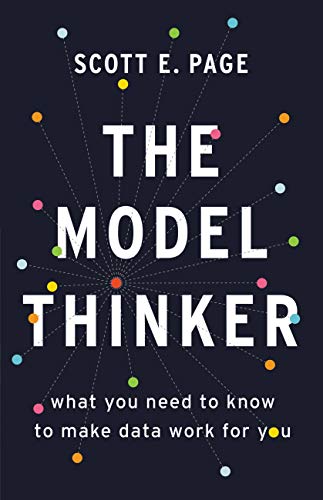
The Model Thinker: What You Need to Know to Make Data Work for You
von Scott Page
It can scarcely be denied that the supreme goal of all theory is to make the irreducible basic elements as simple and as few as possible without having to surrender the adequate representation of a single datum of experience.
I had been wanting to develop a course that would introduce students to the core ideas of complex systems—networks, diversity, learning, large events, path dependence, tipping points
The next fall, I resurrected the course. I contemplated rebranding it as Thirty-Two Models That Will Turn You into a Genius, but the culture at Michigan frowns on hyperbole, so I stuck with Michael’s title: An Introduction to Modeling.
Academic papers, for the most part, follow the one-to-one approach as well, even though they use those single models to explain complex phenomena: Trump voters in the 2016 election were those who had been left behind economically. Or: the quality of a child’s second-grade teacher determines how economically successful that child will be as an adult.5 A stream of best-selling nonfiction titles present cures for our ills based on single-model thinking: Educational success depends on grit. Inequality results from concentrations of capital. Our nation’s poor health is due to sugar consumption. Each of these models may be true, but none is comprehensive. To confront the complexity of these challenges, to create a world of broader educational achievement, will require lattices of models.
To rely on a single model is hubris. It invites disaster.
Eliot’s questioning can be formalized as the wisdom hierarchy. At the bottom of the hierarchy lie data: raw, uncoded events, experiences, and phenomena. Births, deaths, market transactions, votes, music downloads, rainfall, soccer matches, and speciation events. Data can be long strings of zeros and ones, time stamps, and linkages between pages. Data lack meaning, organization, or structure.
As Fyodor Dostoyevsky writes in Crime and Punishment, “We’ve got facts, they say. But facts aren’t everything; at least half the battle consists in how one makes use of them!”
Atop the hierarchy lies wisdom, the ability to identify and apply relevant knowledge. Wisdom requires many-model thinking.
To quote the evolutionary biologist J. B. S. Haldane, “You can drop a mouse down a thousand-yard mine shaft; and, on arriving at the bottom, it gets a slight shock and walks away, provided that the ground is fairly soft. A rat is killed, a man is broken, a horse splashes.”
Knowing reality means constructing systems of transformations that correspond, more or less adequately, to reality. —Jean Piaget
textbooks include tan(x) and cos(x) but not cow(x).2 While the embodiment approach stresses realism, the analogy approach tries to capture the essence of a process, system, or phenomenon.
Proverb: Two heads are better than one Opposite: Too many cooks spoil the broth Proverb: He who hesitates is lost Opposite: A stitch in time saves nine Proverb: Tie yourself to the mast Opposite: Keep your options open Proverb: The perfect is the enemy of the good Opposite: Do it well or not at all Proverb: Actions speak louder than words Opposite: The pen is mightier than the sword
As a result, social phenomena are much less predictable than physical phenomena.
Francis Bacon wrote, “The great end of life is not knowledge but action.”
It is not possible yet to point to a single theory of human behavior that has been successfully formulated and tested in a variety of settings. —Elinor Ostrom
The FDA also cares about the power of the statistical test—the probability that the test shows that the drug works.
The sociologist Robert Merton referred to the tendency for those who have more to also receive more as the Matthew effect: “For unto every one that hath shall be given, and he shall have abundance: but from him that hath not shall be taken even that which he hath” (Matthew 25:29).
To say nonlinear science is akin to saying non-elephant zoology. —John von Neumann
Markov models guide action by distinguishing between policies that change transition probabilities, which can have long-term effects, and those change the state and can only have short-term effects.
This result is known as the median voter theorem.
The decision-maker faces a choice between exploiting (choosing the alternative that has worked best) or exploring (returning to the other two alternatives to get more information).
To gain insight into the explore-exploit trade-off, we compare two heuristics. The first, sample-then-greedy, tries each alternative a fixed number of times, M, and thereafter chooses the alternative with the highest average payoff.
Most people do not try to estimate a Gittins index when confronted with a bandit problem.
In 2012, Obama and Romney spent over 96% of their television advertising budgets in ten states.